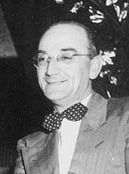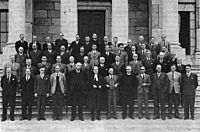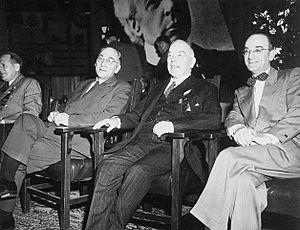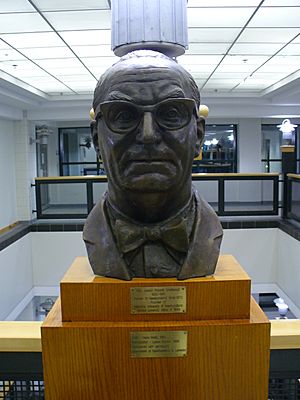Joey Smallwood facts for kids
Quick facts for kids
Joey Smallwood
|
|
|---|---|

Smallwood in 1948
|
|
| 1st Premier of Newfoundland | |
| In office April 1, 1949 – January 18, 1972 |
|
| Monarch | George VI Elizabeth II |
| Lieutenant Governor | Albert Walsh Leonard Outerbridge Campbell Macpherson Fabian O'Dea Ewart Harnum |
| Preceded by | Frederick C. Alderdice as Prime Minister of Newfoundland (1934) |
| Succeeded by | Frank Moores |
| Member of the Newfoundland and Labrador House of Assembly for Bonavista North | |
| In office May 27, 1949 – August 20, 1959 |
|
| Preceded by | New District |
| Succeeded by | Edward S. Spencer |
| In office November 19, 1962 – September 8, 1966 |
|
| Preceded by | Edward S. Spencer |
| Succeeded by | Beaton Abbott |
| Member of the Newfoundland and Labrador House of Assembly for St. John's West | |
| In office August 20, 1959 – November 19, 1962 |
|
| Preceded by | Malcolm Hollett |
| Succeeded by | William G. Adams |
| Member of the Newfoundland and Labrador House of Assembly for Humber West | |
| In office September 8, 1966 – October 28, 1971 |
|
| Preceded by | Charles Ballam |
| Succeeded by | Frank Moores |
| Member of the Newfoundland and Labrador House of Assembly for Placentia East | |
| In office October 28, 1971 – March 24, 1972 |
|
| Preceded by | Alain Frecker |
| Succeeded by | Fintan Aylward |
| Member of the Newfoundland and Labrador House of Assembly for Twillingate | |
| In office September 16, 1975 – June 18, 1977 |
|
| Preceded by | Herbert Gillett |
| Succeeded by | Bill Rowe |
| Personal details | |
| Born |
Joseph Roberts Smallwood
December 24, 1900 Gambo, Colony of Newfoundland |
| Died | December 17, 1991 (aged 90) St. John’s, Newfoundland, Canada |
| Political party | Liberal |
| Spouse | Clara Oates (1901–1996) |
| Children | William R. Smallwood, Ramsey Smallwood, and Clara Smallwood Russell |
| Signature |  |
Joseph Roberts Smallwood (December 24, 1900 – December 17, 1991) was a very important politician from Newfoundland, Canada. He was the main person who helped bring the Dominion of Newfoundland into Canadian Confederation in 1949. After this, he became the first Premier of Newfoundland, serving until 1972. As Premier, he worked hard to improve the economy and modernise education and transportation. He also supported social programs to help people.
Smallwood was known for being very charming and sometimes caused strong opinions. Many Canadians remember him for bringing Newfoundland into Canada. However, people from Newfoundland still have different ideas about his lasting impact.
Contents
Early Life and Career
Smallwood was born in Mint Brook, near Gambo, Newfoundland. His parents were Charles and Minnie May Smallwood. As a teenager, he worked at a newspaper in St. John's. In 1920, he moved to New York City. There, he worked for a socialist newspaper called The Call.
In 1925, Smallwood returned to Newfoundland. He soon met and married Clara Oates. That same year, he started a newspaper in Corner Brook. In 1928, he helped Sir Richard Squires, who was the Prime Minister of Newfoundland, with his election campaign. Smallwood also tried to become a politician himself in 1932 but was not successful.
During the Great Depression, Smallwood worked for different newspapers. He also put together a two-book collection called The Book of Newfoundland. From 1937, he hosted a radio show called The Barrelman. This show helped Newfoundlanders feel proud of their history and culture. He was very good at this job, and his voice was well-known across Newfoundland. In 1943, he left the radio to start a pig farm near Gander.
Newfoundland Joins Canada
After World War II, Newfoundland's economy improved. People started discussing what Newfoundland's future should be. With a small population, many felt Newfoundland was too small to be an independent country.
Smallwood was a popular radio personality and writer. He had often spoken out against British rule in Newfoundland. In 1945, Britain announced that a special meeting, called a National Convention, would be held. This meeting would decide what options Newfoundlanders could vote on for their future. Joining the United States was considered, but Britain did not allow it. Instead, the choices were to return to being an independent country or to continue under British rule. Canada also invited Newfoundland to join, offering good financial support.
In 1946, Smallwood was chosen as a delegate for the Newfoundland National Convention. This group was meant to suggest options for Newfoundland's future. Smallwood strongly believed that joining Canada would bring wealth and a better life. His radio skills helped him a lot. The Convention's meetings were broadcast on the radio, and Smallwood used this to explain why joining Canada was a good idea. He also started a group called the Confederate Association to support joining Canada.
Smallwood became the main supporter of joining Canada. He argued that Newfoundlanders deserved the same living standards as people in mainland Canada. He successfully got the option to join Canada included on the ballot for the public vote. His main opponents were Peter Cashin and Chesley Crosbie. Cashin wanted Newfoundland to be independent again. Crosbie wanted independence first, then closer ties with the United States.
Smallwood's side won in two public votes in June and July 1948. The final vote was 77,869 for joining Canada and 71,464 against. This meant 52.3% voted to join Canada. Many people in rural areas voted for Canada, which was more than the votes for independence in the capital, St. John's. The promise of money for families from Canada was a big reason for the decision.
Smallwood was part of the group that worked out the details for Newfoundland to join Canada in 1947. He also started another newspaper, The Confederate, to promote joining Canada. After the votes in 1948, Newfoundland officially joined Canada. In 1949, Smallwood became the leader of the Liberal Party and the first Premier of the new province.
Leading Newfoundland as Premier
Joey Smallwood led Newfoundland for 23 years, almost without challenge. He usually won elections by a large amount. For most of his time as Premier, the opposing parties had very few members in the government.
He worked hard to improve the economy with his Economic Development Plan of 1951. He also strongly supported social programs, which were paid for by the Canadian government. Smallwood wanted to attract businesses and people from outside Newfoundland. He focused on improving education and transportation. Even though he had some socialist ideas when he was younger, he often worked with banks and was tough on unions that went on strike. He used the knowledge of German businesses to try and build new industries in Newfoundland.
Some of his efforts to industrialise Newfoundland worked well, especially in hydroelectricity (making power from water), iron mining, and paper mills. However, one agreement made in 1969 meant Newfoundland had to sell electricity from the Churchill Falls power dam to Quebec at a very low price until 2041.
Smallwood was willing to support companies to help the province grow. He gave foreign companies special deals to encourage development. He even got involved in a workers' strike in 1959. Loggers were on strike for better pay and working conditions. Smallwood made their union illegal and replaced it with a union supported by the government.
During his long time as Premier, some people said Smallwood was too controlling. He would sometimes sue newspapers like The Telegram if they wrote things he didn't like. He also kept a very close watch on his government ministers. Unlike most other provincial governments, Newfoundland's government did not have a "question period" where politicians could ask ministers questions.
Smallwood announced he would retire in 1969, but then he changed his mind. He decided to run for leadership again against John Crosbie. This led to a difficult contest.
By the 1971 election, Smallwood's government seemed tired. The election resulted in a close tie, with Smallwood's Liberals winning 20 seats and the Progressive Conservatives winning 21. A single member from the Labrador Party supported Smallwood, leading to a three-month standstill. However, Smallwood was forced to step down in January 1972. Frank Moores of the Progressive Conservatives became the new Premier. Smallwood was voted out as Liberal leader soon after. In 1975, he started a new party, the Newfoundland Reform Liberal Party. He finally retired from politics for good at the end of that term.
Life After Politics
After leaving politics, Smallwood went back to writing. He published several books, including his autobiography called I Chose Canada. Later in his life, he started a big project to create a detailed Encyclopedia of Newfoundland and Labrador. This five-volume set was finished by a charity after Smallwood passed away. Smallwood's own publishing company released the first two volumes.
In 1986, he was made a Companion of the Order of Canada. This is a very high honour in Canada. He had hesitated to accept it at first, feeling he should be even more recognized for bringing Newfoundland and Labrador into Canada.
In 1989, a new ferry boat was named MV Joseph and Clara Smallwood in his honour. It was used until 2011.
Death
Joey Smallwood passed away on December 17, 1991, just a week before his 91st birthday. He was buried at Mount Pleasant Cemetery in St. John's, Newfoundland. His wife, Clara, who died in 1996, is buried next to him.
Images for kids





